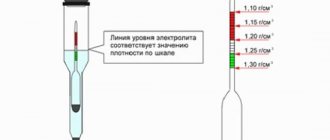The battery voltage and its energy capacity are the main parameters that you first need to pay attention to. You can also find out the degree of charge of the battery by voltage, but for this the car owner must exercise control over the voltage value of the car battery. If you do not forget about performing this procedure, you can increase the service life of the device and save yourself from the negative consequences of its sparseness.
From our article you can find out what the voltage of a car battery is, what value is considered normal, what voltage should be on a charged battery, what the battery voltage is when the engine is running, as well as the procedure for determining the battery charge by voltage using a table.
Charged battery voltage
Power is supplied to a charged car battery using a generator. However, in this case, one circumstance must be taken into account: ensuring the full functioning of the battery using this method is only possible if you drive the car for at least 100 km. Therefore, you must not forget about the importance of this procedure and check the car battery voltage on time.
How many volts should a charged battery have?
How many volts should a charged battery show and what voltage should be on the battery for full operation of the device? The voltage of a charged car battery is 12.5V-12.9V, indicating that the battery is 100% ready for use. A device with this value does not need to be connected to the charger, since the electrolyte may boil away, and this can lead to negative consequences. When buying a battery in a store, keep in mind that the voltage of a fully charged car battery should be 12.6V. However, when purchasing a battery, you may encounter a voltage of 12.5V, but there is no need to be upset, since this is the basic condition for a device that has not been used for a long time.
How many volts should a fully charged battery show?
A car battery consists of 6 cells, each of which produces a voltage of more than 2 volts. Such individual elements are connected in series, so as a result, the voltage of a fully charged and working battery always exceeds 12 V.
Without load
Without load, the voltage at the terminals of a fully charged battery will be 12.6 V. On some models, as well as immediately after charging the battery, this value can be in the range of 12.9 - 13.2 V.
Load fork
Under load
Under load, the voltage at the terminals can be significantly lower than the nominal voltage. This parameter is measured using a load fork, which is a voltmeter with a low-resistance resistor. A fully charged battery should show a voltage value of at least 9 volts when connecting a measuring device.
Thus, if you have a load fork and a multimeter, you can always accurately determine the condition of the car battery, both under load and without it.
Voltage of a charged car battery without load
What should the car battery voltage be without connecting a load? In most cases, without applying additional load, the voltage is 12.6V. However, in some cases, when charging is complete, the car battery can produce a voltage of up to 13.2V.
There are batteries that have the voltage value written on each battery bank. Here you need to carefully study the following: the electrolytic density in the banks should be the same, however, a slight inaccuracy within 0.02 g/cm3 is possible. The battery voltage in this case is 1.9V. If it drops to a value of less than 1.7V, then the device bank has failed.
What voltage should the battery be?
If the device is fully charged, the voltage readings are in the range of 12.5 - 12.9 V. However, these numbers do not say anything about the battery capacity and the degree of its wear. A load test gives a more detailed picture.
From the school physics course we remember the structure and principles of operation of a battery. Immediately after charging there is a high concentration of acid and therefore the highest voltage. Over time, the acid concentration decreases, a gradual discharge occurs - the more intense, the more power consumers are connected to the on-board electrical network.
As noted above, normally the voltage on the car battery should be at least 12 V. There are special tables correlating the degree of discharge of the device from the density of the electrolyte and voltage.
How many amperes are there in a charged battery?
To answer the question of what voltage the batteries should have, we need to consider the battery data, which is located on the device itself. You need to look at such important characteristics as the voltage of a charged car battery without load and the energy capacity of the device. If the voltage is 65 ampere/hour, then the battery during charging can deliver a current of 5A for 11 hours. To find out the number of amperes, you need to connect the product to the charger.
But you need to take into account that the current ratings of different batteries can vary significantly. It all depends on the additional load. The higher its value, the more energy the battery gives off. Also, the voltage on a charged car battery depends on temperature. So, at temperatures below 0˚C, the battery begins to perform its functions worse, since the rate of chemical passage decreases. reactions.
To achieve normal battery voltage under load, manufacturers began to develop technology for good contact of the solution with the plates, which are made of special materials.
How many volts are there in a charged battery?
The normal battery voltage depends on its state of charge. The battery is usually divided into six compartments, each of which provides two V, therefore, the voltage of a fully charged battery in a normally functioning car is 12 V or slightly more.
This indicator changes depending on whether something is connected to the battery as a current “donor” or not. The additional element introduces its own resistance and is reflected in the voltage. So, we know that a car battery without load produces 12-odd V, and with load the value changes to 9 V.
What voltage on a car battery is generally considered normal?
If the voltage varies from 12.5V to 13.2V, then the parameter is in normal condition.
The last value appears after charging. During a 12-hour break in the operation of the car, the voltage is 12.6V-12.8V. To find out for sure, you need to leave the car alone for 12 hours. Before measurement, you must remove 1 terminal from the battery. In the absence of frost, a new battery with an energy capacity of, for example, 50 A/h can hold a charge for 141 days.
What voltage should the battery be?
If the device is fully charged, the voltage readings are in the range of 12.5 - 12.9 V. However, these numbers do not say anything about the battery capacity and the degree of its wear. A load test gives a more detailed picture.
From the school physics course we remember the structure and principles of operation of a battery. Immediately after charging there is a high concentration of acid and therefore the highest voltage. Over time, the acid concentration decreases, a gradual discharge occurs - the more intense, the more power consumers are connected to the on-board electrical network.
As noted above, normally the voltage on the car battery should be at least 12 V. There are special tables correlating the degree of discharge of the device from the density of the electrolyte and voltage.
Under load
To find out the battery voltage, you need to purchase a special device. However, it only allows you to find out the readiness of the battery for further operation and the state of charge of the battery. This product is not suitable for determining energy content. For this reason, there is no way to determine the battery life through this product.
The device has the following equipment, which includes:
- housing with a built-in device, a multimeter;
- spirals that provide resistance;
- cables that have “crocodiles” at the ends for easy connection to the battery;
- switch.
There are 2 types of such products: digital, which show the parameter on the display, and analog, which shows the value using an arrow. The first type is better because it produces a more accurate value compared to the second. Most load forks operate at positive temperatures from 1˚С to 35˚С. But there are products that can work well even at -25˚С, but the cost of such a device will be many times higher than conventional devices. The product can generate current from 100A to 200A.
A battery test using a load fork can be performed within 10 seconds, although according to harmonized standards the test can be performed for 20 seconds.
Under load and no load
Even at low voltage, the battery is quite capable of starting the engine. The main thing is that after this the generator ensures that the battery is charged. When the engine starts, the battery supplies a large current to the starter, thereby sharply losing charge. If the battery is in good condition, the charge is gradually restored to normal values within 5 seconds.
The voltage on a new battery should be between 12.6 - 12.9V, but these values do not always indicate the actual condition of the battery. For example, at rest, without connected consumers, the voltage is within normal limits, but under load it drops sharply and the charge is quickly consumed. This could happen.
Checking the battery with a load fork
That is why measurements are carried out under load. To do this, use a device such as a load fork. This test shows whether the battery holds a charge or not.
The plug consists of a voltmeter, contact probes and a load spiral in the housing. The device creates a current resistance twice the battery capacity, simulating inrush current. For example, if the battery capacity is 50A*h, then the device loads the battery up to 100A. The main thing is to choose the right resistance. If you exceed 100A, you will need to connect two resistance spirals to get accurate data.
Load measurements are carried out with a fully charged battery. The device is held for 5 seconds, then the results are recorded. Under load the voltage drops. If the battery is working properly, it will drop to 10 Volts and will gradually recover to 12.4 V and higher. If the voltage drops to 9V or lower, the battery does not hold a charge and is faulty. Although after charging it may show normal values - 12.4 V or higher.
Engine running
When the car engine is running for more than 10 minutes, the voltage will be from 13.5V to 14.5V. In this case, the parameter will be slightly larger than usual, since the car generator is running. It is necessary to start checking the voltage value after the engine has been running for more than 20 minutes. Then you need to turn on the elements that consume vehicle energy:
- glass cleaners;
- windshield heater;
- stove;
- high beam;
- car radio
After this, the value should change slightly (by about 0.2V). If the value has decreased significantly, then most likely your generator is in a faulty state or there is another situation, for example, if you are using a subwoofer or other powerful device, and the generator cannot cope with such a load, for this reason the voltage begins to sag. In this case, there is only one solution - buy a more powerful generator.
Normal car battery voltage in winter
Due to winter frosts, the electrolytic density of the battery begins to change. In this case, the voltage will depend on how much charge the battery has. If the percentage is large, then the value will increase, and if the charge is low, then the parameter will decrease, and because of this reason, starting the engine will be problematic.
Car owners have the opinion that in winter this parameter is seriously reduced, but in reality this is not the case; in cold weather, chemical reactions begin to work more slowly.
At a negative ambient temperature of -20˚C, the normal voltage value is 12V. However, due to the slowdown in chemical reactions, changes occur such as:
- Reducing the operating energy capacity of the machine's battery. It is half of the declared parameters that are indicated on the label.
- With an electrolytic density of 1.3 g/cm3, the voltage in winter reaches 12.5V.
- If the external air temperature is less than -25 degrees, then the battery stops recharging from the generator.
To increase the density of the battery in a vehicle used in the northern regions, a concentration of a strong dibasic acid is added to the battery.
When the electrolyte density is in the range from 1.30 g/cm3 to 1.32 g/cm3, the normal battery voltage without additional load at negative temperatures will be 13V.
When increasing this concentration, it is necessary to carefully ensure that the electrolytic density does not reach 1.35 g/cm3, as this may cause breakage of the plates.










